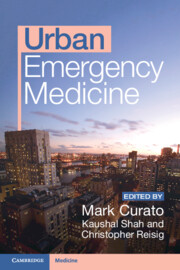Book contents
- Urban Emergency Medicine
- Urban Emergency Medicine
- Copyright page
- Contents
- Contributors
- Preface
- Chapter 1 Caring for the Homeless
- Chapter 2 Disruptive and Dangerous Agitation
- Chapter 3 Penetrating Trauma
- Chapter 4 Substance Use
- Chapter 5 Human Trafficking
- Chapter 6 Travelers from Overseas
- Chapter 7 HIV, AIDS, and Tuberculosis
- Chapter 8 Asthma
- Chapter 9 Physician/Patient Discordance
- Chapter 10 LGBTQIA+ Care
- Chapter 11 Child Maltreatment
- Chapter 12 Care of Vulnerable Elders
- Chapter 13 Civil Unrest: Caring for Police and Protesters
- Chapter 14 Terrorism and Mass Casualty Incidents
- Chapter 15 Overcrowding, Triage, and Care Rationing
- Index
- References
Chapter 5 - Human Trafficking
Published online by Cambridge University Press: 20 July 2023
- Urban Emergency Medicine
- Urban Emergency Medicine
- Copyright page
- Contents
- Contributors
- Preface
- Chapter 1 Caring for the Homeless
- Chapter 2 Disruptive and Dangerous Agitation
- Chapter 3 Penetrating Trauma
- Chapter 4 Substance Use
- Chapter 5 Human Trafficking
- Chapter 6 Travelers from Overseas
- Chapter 7 HIV, AIDS, and Tuberculosis
- Chapter 8 Asthma
- Chapter 9 Physician/Patient Discordance
- Chapter 10 LGBTQIA+ Care
- Chapter 11 Child Maltreatment
- Chapter 12 Care of Vulnerable Elders
- Chapter 13 Civil Unrest: Caring for Police and Protesters
- Chapter 14 Terrorism and Mass Casualty Incidents
- Chapter 15 Overcrowding, Triage, and Care Rationing
- Index
- References
Summary
Human trafficking is a global public health problem that affects people of all races, nationalities, socioeconomic classes, and genders. Human traffickers prey on the vulnerable, strip them of their basic human rights and inflict physical and psychological damage to their victims and their communities. The true scope of the problem is unknown because of the hidden nature of the crime. Over 40 million people are estimated to be victims of human trafficking worldwide – 25% of whom are children. Over 24 million people are thought to be trapped in forced labor and 4.8 million in sex trafficking. Women and girls are estimated to be the majority of victims and account for 71% of victims of human trafficking and 99% of sexual exploitation. However, trafficking of men, boys and other genders is highly underrecognized. Additionally, urban areas may have a high density of diverse under regulated or under paid employment that could be particularly difficult for clinicians to identify human trafficking. Clinicians, particularly in the emergency department, have the responsibility to identify, protect, and provide resources to people experiencing human trafficking.
- Type
- Chapter
- Information
- Urban Emergency Medicine , pp. 56 - 66Publisher: Cambridge University PressPrint publication year: 2023



